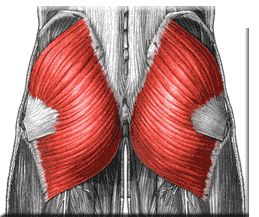You guys asked for it, so here you go – a month of glute training! Over the next 4 weeks, we’ll share our favorite exercises, tips, tools, and everything else you need to shape, tone, and get that backside you’ve always desired.
It’s going to be a blast. Let’s get right into it.
A Little glute background. What the heck are glutes anyway?
“Glutes” refer to the 3 major muscles of your butt. You have the gluteus maximus, gluteus medius, and gluteus minimus. There are others, but for the purposes of this article, let’s stick with these 3. The biggest muscle in the body and one that most of you have heard of is the gluteus maximus. This is the powerhouse muscle. This is the one most people refer to when talking about glute training.
The main function of the gluteus maximus is hip extension (think of lifting your leg behind your body). It is for this reason that you’ll feel the gluteus maximus firing when walking uphill or up a set of step stairs or when coming out of a squat position. But listen to this – you will NOT engage the gluteus maximus in normal walking or even jogging. Yes, you heard that right. This is a huge factor in why so many people are walking around with no glutes!
Even if you’re active and walking often or even lifting weights, you wont stimulate the glutes unless you train them. This means walking up hills, squatting, sprinting, or many other exercises that involve hinging the hip.
Let’s now take a look at the other 2 major muscles of the butt – gluteus medius and gluteus minimus.
As you can see, these 2 muscles are much smaller than the gluteus maximus. The main function of these 2 smaller muscles is to help stabilize the hip and abduct (move away from the center) the leg. Think about lying on your side and lifting one leg off the ground, that’s both gluteus medius and minimus in action. If you were to place your hand on the outside of your hip, you’d feel both those muscles engaged.
So now that we have a basic understanding of the glutes, let’s talk about a few quick concepts when training the glutes.
1) You need to activate your glutes first.
This is a huge point that cannot be forgotten! If you jump into glute training without good glute activation, you’re in for trouble. You’ll end up using your lower back which is not good. Read this post to learn more. The bottom line is that far too many of us are walking around with turned-off glutes. Call it flat butt, saggy butt, whatever you want – the cause is mostly the same – it’s weak, underused butt muscles from inaction. We sit too much, spend excessive time in our cars, and we don’t squat often.
Soooo, step 1 is to get your glutes turned on. That’s what we’re going to talk about today.
2) Use proper form.
The glutes are huge muscles that respond really well to heavier loads. But if you use heavier weights with bad form you’re increasing your risk for injury, especially in your lower back. Learn to squat with a flat back and a braced core. Planks are great for this. Or maybe there is something going on with you flexibility that’s limiting your ability to perform exercises correctly. This has to be taken seriously.
3) Use different angles and heavy enough weight to most efficiently stimulate the gluteus muscles.
Air squats and bodyweight lunges are good exercises for training for your legs, but they will not provide enough resistance to properly stimulate the the huge, powerful gluteus maximus muscle. You need to use weights to get enough stimulation to this large muscle. Also by adding exercises that work different angles, you stimulate all 3 glute muscles which will get you the best results.
Today’s exercise – The hip thrust
A hip thrust is also known as a bridge or hip press. This is great beginner exercise that teaches you how to engage and activate the glutes. The hip thrust primarily works the gluteus maximus muscle. If this seems too easy, there are a few ways to add difficulty. One leg hip thrusts are great too. Simply lift one left and keep it off the ground to add more resistance to the grounded leg.
Again, with all these exercises, make sure your glutes are doing most of the work. If you feel this in your lower back, there’s a good chance your glutes aren’t firing properly and your lower back is doing the work. This is NOT what you want. Go back to the easier variation and focus on squeezing your glutes as hard as you can with every rep.
Quick tip – make a fist and tap your butt at the top of the hip thrust. It should be rock solid! Just like you’re cracking walnuts baby!!
Here’s Julie performing a weighted hip thrust using a kettlebell. This variation will be slightly harder than the unweighted bridge for obvious reasons. You can also use a dumbbell here. Again, the key is to use your glutes to drive your hips up instead of hyperextending your lower back.
Once you master the dumbbell, you can then progress to a heavier weight or you can start using the barbell as pictured here.
Remember, the glutes are huge muscles and therefore need plenty of stimulation. This is why heavy barbell hip thrusts are one the most effective exercises in growing the gluteus maximus. But we need to start slowly and make sure you’re firing the glutes and using good form.
So there you have it. Day 1 of glute training in the books. Class adjourned, let’s go awaken those glutes! We’ll dive a little deeper next week, stay tuned!
Nick








